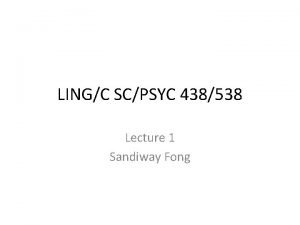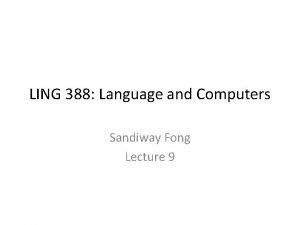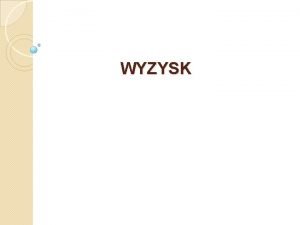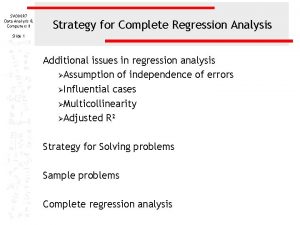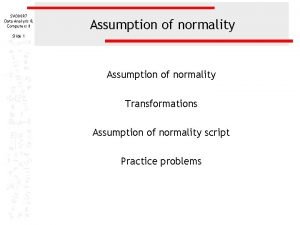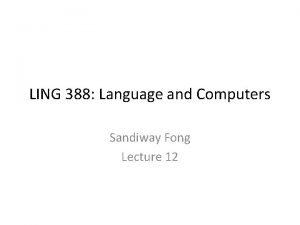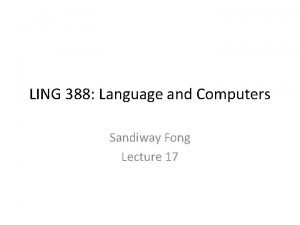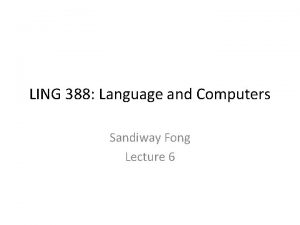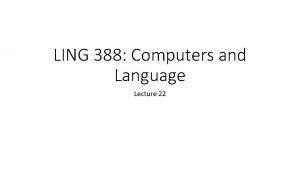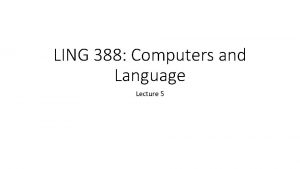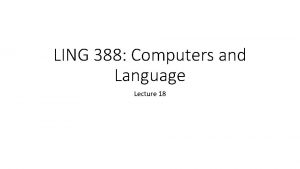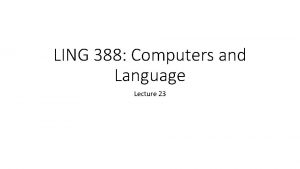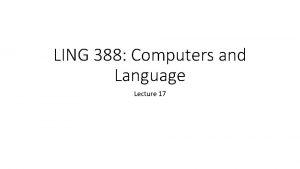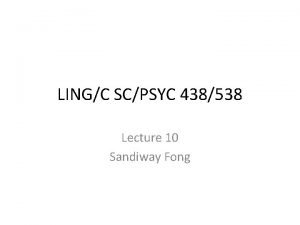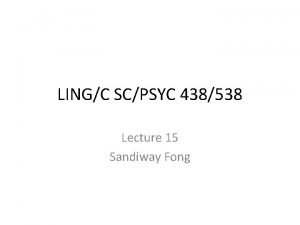LING 388 Language and Computers Sandiway Fong Lecture









![Unification • Lists: – [] – [1, 2, 3] also can be written as Unification • Lists: – [] – [1, 2, 3] also can be written as](https://slidetodoc.com/presentation_image/66d60ac7487dfcef5e9795b8dc928832/image-10.jpg)










- Slides: 20

LING 388: Language and Computers Sandiway Fong Lecture 4

Administrivia • Today’s Topics – want to make sure everyone is able to run SWIProlog – SWI-Prolog (6. 6. 6) on the mac – Introduction to Prolog contd. Lab class: Unification – Homework 2: due next Wednesday by midnight • email: Ben Martin bamartin@email. arizona. edu

SWI-Prolog app on Mac • Two strikes against the SWI-Prolog app: 1. Default directory is / (root, non-writeable), not your home directory – fixable 2. Uses the X 11 Window System (which runs under OSX) – very slow

SWI-Prolog App on Mac Takes two parameters: (1 st) current working directory, (2 nd) the new working directory

SWI-Prolog App on Mac

SWI-Prolog App on Mac Takes a very long time to fire up because it fires up PCE-EMACS running under the X 11 Window System Better options: aquamacs runs natively under OSX or use your favorite plain text editor

Prolog online resources • Some background in logic or programming? • Useful Online Tutorials – Learn Prolog Now! • Patrick Blackburn, Johan Bos & Kristina Striegnitz • http: //www. learnprolognow. org – An introduction to Prolog • Michel Loiseleur & Nicolas Vigier • http: //boklm. eu/prolog/page_0. html

SWI-Prolog Chapter 2 of Learn Prolog Now http: //www. learnprolognow. org/lpnpage. php? pagetype=html&pageid=lpn-htmlch 1

Unification Data Types: • Variables (begin with an uppercase letter): – e. g. X, Y 3, Var… • Atoms (numbers or begin with a lowercase letter): – e. g. x, var, 12. 34 • (Complex) terms (functor + 1 or more arguments): – e. g. f(1, x), g(X), g(f(1, x)) • Lists: – e. g. [] – [1, 2, 3] – [f(1), x, Y 3] (empty list) (list containing three numbers) (list containing a term, an atom and variable)
![Unification Lists 1 2 3 also can be written as Unification • Lists: – [] – [1, 2, 3] also can be written as](https://slidetodoc.com/presentation_image/66d60ac7487dfcef5e9795b8dc928832/image-10.jpg)
Unification • Lists: – [] – [1, 2, 3] also can be written as [1|[2, 3]] – Notation: • [head|tail] vertical bar (|) separate the head of the list from the rest of the list, the tail. – So [1, 2, 3] is equal to (and unifiable with) [1|[2, 3]] – i. e. [1, 2, 3] = [1|[2, 3]]

Unification – Variables (begin with an uppercase letter): – e. g. X, Y 3, Var… – Atoms (numbers or begin with a lowercase letter): – e. g. x, var, 12. 34 • Single quotation marks: – ‘x’ = x – ’ 12. 34’ – not a number, not unifiable with 12. 34 – ‘X’ – not a variable, ‘X’ is not equal to variable X but they are unifiable – single quote can be part of an atom: e. g. ‘’s’ apostrophe s

Exercise 1 • Using the Prolog interpreter, evaluate the following queries: 1. 2. 3. 4. 5. 6. 7. X = mia, X = vincent. X = mia ; X = vincent. X = Y. [1, 2, 3] = [1|[2, 3]] [1, 2, 3] = [X|Y] [1, 2, 3] = [X|[3]] [1, 2, 3] = [X|[Y]] (, = logical and, conjunction) (; = logical or, disjunction) Note: if a list is too long, SWI Prolog uses … instead of printing the whole list. Type w to get the full display.

Exercise 2 • Using the Prolog interpreter, evaluate the following queries with complex terms: 1. 2. 3. 4. X = father(mia). vincent = father(mia). X = father(Y), Y = father(mia). S = s(np(john), vp(v(likes), np(mary))), S = s(np(X), vp(v(Y), np(Z))).

Exercise 3 • According to learnprolognow. org, this shouldn’t work in standard Prologs, try it: • Try: 2. father(X) = X, father(Y) = Y, X = Y. 3. father(X) = Y, father(Y) = X.

Exercise 4 • From section 2. 2 on learnprolognow. org, try the following query: How many solutions are there?

For Homework Exercises You’ll make use of the following: 1. + is the negation operator: – vincent = mia. – + (vincent = mia). (false) (true) - same as above 2. there’s a special variable _ (underscore), known as the anonymous variable. It doesn’t do anything and Prolog doesn’t report its value. – it’s used when you don’t want to give a variable a name or don’t care what it’s called… – Try: • X = _, Y = _.

Homework Exercise 1 • Consider Exercise 4 again. • Assume one cannot be jealous of oneself. • How would you change the rule or query so that this case is excluded from the answers? • (show your code and query)

Homework Exercise 2 • A word that’s a palindrome is spelt the same way backwards and forwards, e. g. kayak, radar or noon. We can check for “palindrome-hood” using Prolog lists. • Run the queries: – [k, a, y, a, k] = [X, Z, Y, Z, X]. – [c, a, n, o, e] = [X, Z, Y, Z, X]. (5 letter palindrome) 1. Where can we use the anonymous variable (_) in the palindrome check above? 2. What’s the four letter version of the palindrome check? • (Give examples)

Homework Exercise 3 • There’s a built-in predicate called reverse(List 1, List 2). Run the following queries: – reverse([1, 2, 3], [3, 2, 1]). – reverse([1, 2, 3], L). – reverse(L, [1, 2, 3]). • Explain how you can use reverse/2 to check for palindromes of any length. • (Give examples)

Homework Exercise 4 • Extra Credit. Write a rule and query (or query) that solves the following puzzle: Hint: use the list representation
 Google translaze
Google translaze Swi prolog examples
Swi prolog examples Sandiway fong
Sandiway fong 01:640:244 lecture notes - lecture 15: plat, idah, farad
01:640:244 lecture notes - lecture 15: plat, idah, farad Timothy fong ucla
Timothy fong ucla Eugene fong
Eugene fong Bruce fong dts
Bruce fong dts Disguises by jean fong kwok
Disguises by jean fong kwok Caroline fong
Caroline fong Moy fong menu
Moy fong menu Fion fong
Fion fong Irene fong
Irene fong Dr warren fong
Dr warren fong Hwu webmail
Hwu webmail Vle learning moe edu sg login
Vle learning moe edu sg login Kristine fong
Kristine fong Art 388 kc
Art 388 kc Wac 388-877
Wac 388-877 Sw 388
Sw 388 Shattine
Shattine 388 hymn
388 hymn
